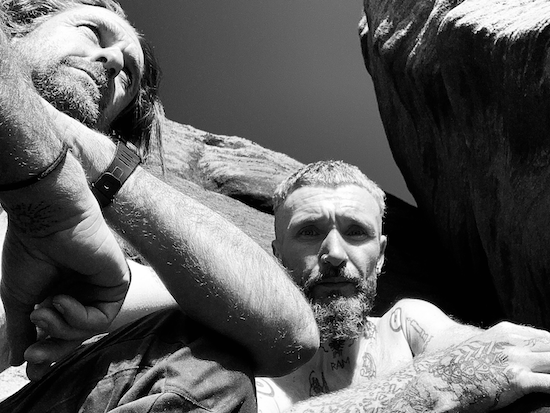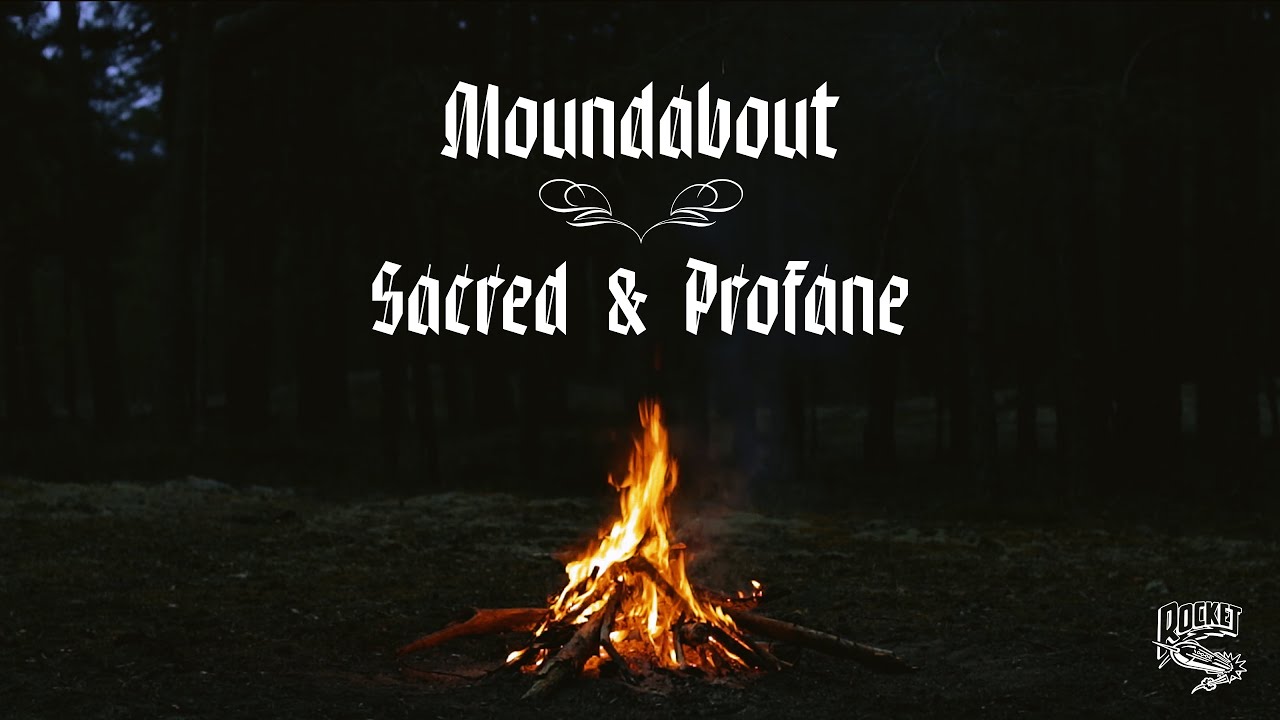Moundabout’s new single, ‘Sacred & Profane
When the brightly-coloured, many-legged, psychedelic carnival of Gnod blew through Leitrim, Ireland, 13 years ago, to play Woven Skull’s Hunter’s Moon festival, leader Paddy Shine hit it off with musician Phil Masterson of Los Langeros, Damp Howl and Bisect and the pair stayed in touch. Shine was undergoing something of an epiphany, realising that the Irish underground scene was one of the healthiest and most vibrant in the world and the seed of an idea – he could return home from Salford to Roscommon where he had grown up – was beginning to take root.
The pair finally hooked up to make music together on one of Gnod’s R&D tours across the ROI early 2018 and then the following year, they ended up jamming in Roscommon. Masterson explains: “The same weekend Paddy and I started playing together we took a road trip to Drogheda to see Nurse With Wound perform at an arts Festival there. On the way we stopped off at the Loughcrew megalithic cairn. It was a diversion; we took a roundabout route… a moundabout.” And with that, a new project was born. The pair spent hours jamming in Shine’s newly built home studio, free-exploring acoustic instruments; the results became Moundabout’s first release, North Cairn, released in 2020 on Gnod’s friends and family tape label, Tesla.
Their first album proper, released last year by Rocket Recordings, Flowers Rot, Bring Me Stones, was influenced by Irish megalithic art and ancient passage tombs built between five and six thousand years ago. As the modern name passage tomb suggests, they were in all likelihood actual liminal zones bridging this world and the next; charnel houses, stone age reliquaries, bone gardens, cairns vibrating between planes and states of being. The kerbstones and pillars of these structures are carved with a hypnotising array of spiral, serpentiform and lozenge-shaped patterns; alongside is chiselled the oldest known representation of the moon made by man.
Listening to Flowers Rot, Bring Me Stones was like entering a trance state while staring at one of these spiral carvings. Like following a ridged epidermal loop inwards or tracing the spiral of an ammonite towards the centre, immersion in this music sees the listener travelling both temporally backwards and spatially inwards simultaneously. We are invited to consider this folk music – ostensibly orally transmitted music often concerning national identity and culture played on traditional instruments – as the glowing helix of a continuum stretching way back beyond the revival of the 1950s and 1960s to an eternal vibrancy that predates classical antiquity and Irish civilisation itself. This journey – geographical and geological, as well as psychological and spiritual – carries the listener inwards from the coast (‘The Sea’), as well as down into the top strata (“How many bog bodies are waiting to be found”).
Their excellent new album An Cnoc Mór, out on Rocket this Autumn, is constructed with similar building blocks but with one difference of temperament and head space. Masterson explains: “Flowers Rot was not a straight edge record. Anytime myself and Paddy have got together in the past, a decent hike in the morning has been on the cards before some healthy food and then getting on with the business at hand. The initial tracks were recorded in The Lodge where I live in Coolyduff, Cork, after such a healthy morning but also after some mushrooms and cannabis. The second session, for overdubs and vocals, took place at Paddy’s place in Roscommon over a fairly indulgent weekend of work involving both of the above as well as some K and possibly some MDMA. I had at the time a lunchbox of vices, which I had found in the field across the road from where I live."
The pair rented a yurt in the Galtees early 2022 and tried to repeat the formula for their second album but found that this time the magic lunchbox was hindering rather than helping their progress. Masterson called the results “pretty messy” and Shine adds: “Drink and drugs were slowing me down and really not inspiring me at all. I don’t think we need that stuff at all to play together because we naturally find a way into the music anyway. Moundabout has always been about getting out in the surroundings, hiking, swimming, chatting and experimenting with certain substances. An Cnoc Mór was recorded with all those influences… just minus the substances.”
The album is named after Cnoc Mór na nGaibhlte (or The Big Hill Of The Galtees), Munster, near to where the pair hired a “yurt-like structure” and began playing, with Shine also making field recordings in places where the energy felt good. It is one of Ireland’s tallest mountains (the 12th at 918 m above sea level to be precise) and prized by hill walkers as being one of Ireland’s 13 ‘Munros’. Masterson adds that one of Moundabout’s more memorable hikes was to the top of the Big Hill on a day it was so windy they could barely stand up straight, and then on the way back down the pair became “pleasantly lost”. It is this getting lost in liminal zones, at thresholds, where boundaries merge, that is key to the Moundabout sound. The Galtees is an Irish mountain range where the counties Tipperary, Cork and Limerick meet and provided the inspiration for this new set of songs, while their first was recorded in Roscommon at the junction between counties Westmeath, Offaly and Galway. Shine adds: “We seem to have found ourselves recording and finishing albums in places where the boundaries have become blurry.”
The set up of Shine on acoustic guitar, Masterson on electric guitar, both on vocals and sparse electronic accompaniment from an antique Hammond drum machine Shine found in his auntie’s attic and old analogue synth, plus field recordings, remains the same but this time the pair push further out on tracks such as ‘Step In Out Of That’ which calls to mind Egypt-based free psych trio The Dwarfs Of East Agouza and reaches its apogee on the glorious, sunburst of New Weird Éirana ‘Instinct, Eye And Mind’ which calls to mind Michael Chapman at his most ragged and the borderless fourth world guitar peregrinations of Mike Cooper.
If the voyage that Flowers Rot took us on was one out of modernity into a vibrant megalithic antiquity, it feels like An Cnoc Mór is taking us even further back: into an unoccupied landscape. Masterson says: “These hills were hills long before homo sapiens set foot on them, gave them names and stories and insulted them with egotistic concepts such as ‘conquering them’.”
Shine concludes: “The vibe of An Cnoc Mór for me is all about being completely present and in awe of the harsh beauty of nature. I had such poor phone and internet signal out there for a month that it allowed me to get quiet and get in the now and explore the landscape and think about it without constantly Googling shit. It was January when we were there and we got all the weather: sun, snow, hail and wind. There was no choice but just to be out in it. I love that.”



